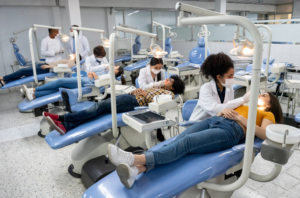Exploring flipped classrooms in dental education and supporting structures
As technology advances, students become increasingly familiar with technology and digital resources. Students can access a wealth of knowledge at the touch of any device. Learning occurs at any time, on demand. Traditional lecture delivery does not capture and stimulate the mind of younger generational students over a long period of time.
New technologies and interactive methods of teaching can better engage and motivate learners.
Dental students traditionally experience in-person lectures followed by hands-on practical sessions and competency-based assessment. In Techniques, consider how the use of a flipped classroom (FC) approach can improve the student experience.
Flipped classroom: a hybrid model of instruction
The pedagogical methodology of a flipped classroom (FC) requires students to conduct most of the content-based learning prior to the classroom session. This approach leaves higher-order learning activities to be explored in the classroom.
Many dental schools use FC models with positive outcomes. A study from Athens, Greece, in the School of Dentistry, separated a class into traditional and FC group methods of teaching in oral radiology. The results showed that the FC group performed significantly better on a post-course knowledge test. Students appreciated the method of delivery and believed that the class meetings helped to clarify difficult issues. Students also reported positive attitudes on their effectiveness, motivation and engagement throughout the course.

In the United States, Harvard School of Dental Medicine changed and developed their second-year dental anatomy course into an FC model. The outcome was overall positive, with 40% of students having already engaged in online dental study. And 85% of students reported that they would like more FC classes in the dental program. Students felt that FCs made good use of class time and that the time spent was more interactive and collaborative compared to traditional lectures.
The rise of virtual technology and haptics supplementing online delivery opens even more possibilities for FCs in practical dental education. A study published in 2013 compared student groups who drilled restorative preparations using the traditional method (e.g., plastic teeth) and using a virtual haptic technology to perform the same procedure. Students responded positively to the virtual technology as they obtained immediate feedback from the program. Further, practice attempts were not limited by the physical supply of teeth.
Recommendations for implementing FC
The FC classroom model could apply to any didactic course where content may be studied independently. During face time, students then engage with peers in discussion and collaborative skill development.
Organize course content into modules. And make modules available to the students at least a week in advance of the classroom meeting. Teachers, you could offer a pre-recorded virtual lecture via programs such as PowerPoint or webcam capture technology, including slides and notes. Other forms of remote instruction may include videos that demonstrate the procedure students will soon practice in person, or interactive modules that guide students through a clinical decision-making process.

Once in the classroom, instructors answer students’ questions, oversee peer discussions, or even lead students in teaching one another to demonstrate proficiency. The instructor provides feedback and clarification, and conducts competency-based evaluations in real time.
Most career and technical education (CTE) courses require hands-on practice and instruction. As such, when applying the flipped classroom model, students are expected to know how to perform basic procedures before the classroom session. Virtual technology and haptics provide an avenue of self-study where, given the tools and technology, students can learn on a practice station either at home or at school without direct supervision. Students study and practice independently. And then they meet in person with faculty to refine their skills. In this way, students experience more opportunities to reduce misunderstandings or confusions and apply their learned skills.
Considerations when implementing flipped classroom
An FC classroom does not eliminate the hands-on practical sessions that are crucial to a developing dentist. This interactive patient aspect is inseparable to the practice of dentistry. Online dental education must be implemented, organized and presented with an in-person component for flipped classrooms to ensure a positive impact on students.
To flip a course taught traditionally, CTE administrators should consider the various financial and time investments needed. This involves acquiring the online technology, as well as supporting the faculty to learn new tools and create courses within the school’s curriculum, ensuring continuity. Teachers should also provide support to students as they begin to develop their skills in self-regulated learning. Students may struggle to prepare adequately for classes while adjusting to a new method of learning. Ensure that students can access the support they need to succeed in online learning. And check up on students’ progress at regular intervals.
Conclusion
An FC method and the ideas behind revising dental curricula applies to learning in the health sciences and beyond. CTE programs can apply the FC model to maximize effective classroom time and help motivate students to become self-regulated learners.
Dr. Eve Chung is an alumni and assistant professor in residence at the University of Las Vegas, School of Dental Medicine. She works as a clinical instructor for undergraduate dental students working in patient care and serves as director for pre-clinical courses such as Dental Anatomy and Occlusion.
Dr. Xue Xing is an assistant professor in the Department of Teaching >amp; Learning at the University of Nevada, Las Vegas. Her research interests focus on college/career preparation and students’ transition outcomes to postsecondary education and work. She is a 2021 fellow in the Postsecondary Leadership Success Program at ACTE – Sponsored by ECMC Foundation.






